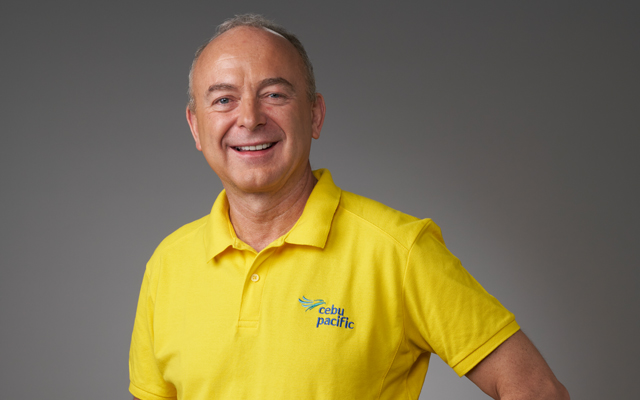After almost three decades in operation, Cebu Pacific has become an LCC that contributes significantly to the Philippines’ travel and tourism industry. It closed 2024 with 60 per cent of the domestic market share in its hands, along with a network of 37 domestic and 26 international routes as well as a high ESG rating under its belt. CEO Mike Szucs recounts the airline’s growth and shares forward plans as well as sustainability considerations
 The Cebu Pacific story says the airline is committed to flying where Filipinos are since its beginnings in 1996. Is this still the reason driving the airline’s network decisions?
The Cebu Pacific story says the airline is committed to flying where Filipinos are since its beginnings in 1996. Is this still the reason driving the airline’s network decisions?
Our route strategy is really rather simple. We focus on the domestic market, which is huge. There’s 120 million people – thereabouts – in the country, and it’s an archipelago, so there isn’t any other way to get between those islands.
Hence, the LCC is a fundamental part of the Philippine economic fabric.
Cebu Pacific has the perfect model for that – we are a very reliable, very affordable, on time, and safe airline.
But we are a bus service in the sky. When our average sector length is an hour and a half, we don’t need to offer a fully-flat business class seat and a glass of ice. And we have to be affordable because the Philippine consumer is price sensitive.
The next consideration is, where do we fly? We like to focus on areas that are within a four-hour flight time around Manila. We serve short sectors really well. We want to focus on serving the two billion people living within that zone, as well as all the Filipinos in the Philippines who want to go to destinations within that four-hour zone.
Well, we do have a few destinations that sit outside of that zone. We now fly to Dubai, Sydney and Melbourne, where many overseas Filipino workers reside.
The airline most recently commenced thrice-weekly flights to Sapporo, Japan on January 16. It is outside of the four-hour fly zone. How well is this route doing so far?
It is already proving to be an extremely popular service, so we are very happy to be flying there year-round. We started the route with an A320neo, and within a couple of weeks we upgraded to an A321 because of the strong demand.
Filipinos love Japan. I mean, the world loves Japan at the moment, and that is due to the destination’s affordability.
Well, Sapporo lies beyond the four-hour radius, but it is still a short-haul flight. There is big demand for Japan and we do make route decisions based on demand – we are a business after all and have to make a living. (laughs)
Which routes are a big hit with Filipinos in the Philippines?
Filipinos love to travel. When you look at the demographic of the Philippines, you will see a lot of young people. That is rare, as the world is ageing. The Philippine demographic is a perfect pyramid, with a large population in the 20 to 35 year-old segment.
These young people want to travel. Affordability is important to them, but they also want to go for the experience and post it all on social media.
Of course, there is also great interest in domestic tourism. Someone living in Manila would go to Boracay for a break.
Do you get a mix of leisure and business travellers and price-conscious travellers and wealthy ones? Does such segmentation matter to Cebu Pacific?
We get a mix, yes. More and more we’re getting business travellers coming on because we’re offering a good product and good service. We also get the wealthy ones.
You can go from the Philippines to Sapporo via Hong Kong with Cathay Pacific, which will cost an arm and a leg but you can get yourself a business class seat. However, you will have to connect. On Cebu Pacific, you and your ski gear can get to Sapporo direct in five hours. Cebu Pacific is comfortable, it is clean, it has good service, and it is on time. And you know what? It’s a lot cheaper, too. You can save on that flight and spend it all on the slopes.
Legacy carriers will go big on segmentation. We don’t tend to do that; we just want to make sure that we are available to everyone.
Airlines play a big part in enabling countries achieve their tourism goals. The Philippine Department of Tourism must love Cebu Pacific, as your airline operates the widest network in the country.
We operate 37 domestic and 26 international routes. We are touching 60 per cent of the domestic market share now. We have a lot of healthy discussions with the government. So, yeah, we’re probably quite important. And we don’t take that lightly. Because we’re important, we know we’ve got to be good.
Where else in the world could Cebu Pacific fly next to boost arrivals?
Well, anywhere in that four-hour flight radius! We are focusing on our normal catchment, and we’ll add frequencies and the odd new route. We commenced services to Thailand’s Chiang Mai last year and Don Mueang, which is the alternative entry point to Bangkok.
Will we look at more long-haul additions? The route has to be a real standout for us. Will we do another one in the Middle East? Saudi Arabia is becoming such a big market on its own, so it is something we might look at. India is another big market. Do we need to fly to India? We certainly need some analysis on that.
We have to be very careful about doing anything that steps outside of our normal catchment. If we were to decide on India, for example, we could do it on the A330neo, but that would be a lot of capacity to put into India. So, do we do it with a narrow body? If so, we would need to look at something like the A321LR.
Personally, I’m very biased; I want to stick to that four-hour zone. However, India is so big, so we can’t just dismiss (the possibility of flying there). Other airlines will have a go at a direct India-Manila flight. That is fine, we don’t need to be the first mover. If the route is a commercial success, we will go in and I am pretty certain that we’ll be a more efficient and lower-cost operator.
Cebu Pacific airline placed an order for 70 A321neo last October. Is there a timeline for delivery and how will they be deployed?
We have a lot of flexibility in terms of delivery, with a timetable that goes through 2034. The first of those will definitely come in 2029.
By the way, we’ve got lots of additional purchase rights, so it’s a minimum of 70 aircraft but up to 152. Our orders and delivery depends on when the Bulacan airport comes online.
(Editor’s note: Supply chain delays have caused the New Manila International Airport in Bulacan province to likely be operational in 2028 instead of initial projections for 2027)
Once Bulacan is ready, we will want to put 10 or 15 aircraft in and rapidly establish there. It is in the Manila catchment, and our new orders are in part linked to the new airport.
In terms of overall growth perspective for the next three or four years and with the uncertainty around the supply chain, it is likely that we might need to top up (our fleet) either from aircraft lessors or find other other creative means to bring some of our orders forward.
Generally, we are very pleased with our order and our timing was just right.
I’m curious – how quickly can a new aircraft be ready from the point an order is made, and how quickly can it be brought into service?
Our order will come in five years. With the ongoing supply chain backlog, you’d be lucky if you went to Airbus today for an A320 and it assigns you one in 2031. As for speed to deployment, we’d like it to be in operation as soon as it arrives in in the country. We don’t want the aircraft sitting on the ground.
How does your choice of aircraft for the fleet fit into your sustainable aviation goals?
The neo engines offer a fuel burn savings of 15 to 20 per cent. That’s massive.
We also utilise the floor space of the aircraft better than anybody else. We’re high density, and we make no apology for that. It is good for economics, helps keep the fares low for the consumer. It’s also good from an environmental perspective because it means that each passenger is travelling with a smaller footprint than if they were flying in business class or in their own private jet.
Cebu Pacific flew a sustainable aviation fuel (SAF)-powered flight from Singapore to Manila in September 2022 and from Narita to Manila in October 2023. How is the airline progressing with its plans to integrate blended SAF for its entire commercial network by 2030?
It was not done on a consistent basis, but to establish that we could do it. It is a step in the right direction, but you know we have another 100 steps in this ladder towards sustainable flight.
We are the only Philippine carrier that has flown with SAF. We got a few awards last year for our sustainability initiatives. One of them was our AA ESG rating from MSCI. We are the first local airline in the Philippines to receive this distinction, placing us among the top airlines globally in managing ESG risks and opportunities. There are only about five or six airlines in the world that have that AA rating.
There is not enough SAF (to do that consistently now) and it is so expensive. We are working with aircraft manufacturers and the likes of Neste (a leading producer of sustainable aviation fuel and renewable energy) to see what’s the long-term solution.
We do many other things to cut down on emissions. One of the things we do is to give our pilots a monthly report on how their performance is in terms of climb, cruise, descent, taxi, etc and the resulting fuel they’re uploading. I am a former pilot, and when I was flying, we used to do a single-engine taxi to save fuel. We don’t need to call them out on their fuel use; our pilots don’t want to stand out when it comes to fuel consumption, so they will do better.
We are also working on shortening routes to reduce fuel usage, and electrifying everything that we can, from office operations to groundhandling equipment.
Last question – many major travel suppliers are building a direct channel to the end customers. What is Cebu Pacific’s approach to relations with travel agents?
We like direct relationships, full stop. One of the advantages about direct relationships is that we have customer details, and that’s often the most difficult thing to obtain when working through third parties.
Don’t get me wrong – we value agents. The biggest single problem in customer management is when things happen and we cannot contact the passenger. It can become difficult when we are not able to service the needs of the customer.
We are not trying to see the end of travel agents and we don’t need us to own the customer – we just need to be able to get in touch when something happens.











